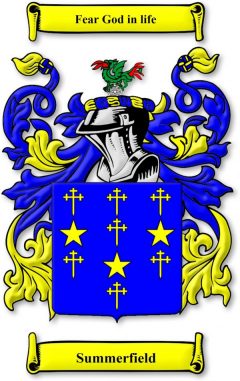My Great Grandfather.
WILLIAM SUMMERFIELD was born on 15th October 1852 in Manchester, Lancashire. He died on 8th June 1929 in 39 Eden Street, West Hartlepool, Durham. He married Isabella Laurie, daughter of William Laurie and Catherine Dobie McLeod on 24th October 1881 in Stranton, West Hartlepool. William Summerfield and Isabella Laurie had the following children:
- WILLIAM SUMMERFIELD was born in 1882 in West Hartlepool.
- CATHERINE SUMMERFIELD was born in 1884 in West Hartlepool.
- JOHN SUMMERFIELD was born on 31st December 1885 in West Hartlepool. He died in 1919 in Russia. He married Sarah Lee, daughter of William Lee and Elizabeth Young on 15th May 1911 in West Hartlepool. Sarah was born in 1888 in West Hartlepool. She died in 1973 in West Hartlepool.
- ELIZABETH SUMMERFIELD was born in 1887 in West Hartlepool. She married Thomas W Westgarth, son of Thomas Westgarth in 1914 in West Hartlepool, Durham. Thomas was born about 1890 in West West Hartlepool, Durham.
- ROBERT SUMMERFIELD was born in 1889 in West West Hartlepool, Durham, England. He died on 21st Jan 1926 in 39 Eden Street, West West Hartlepool. Died of 1) Pulmonary Tuberculosis and 2) Syncope
- ISABELLA SUMMERFIELD was born in 1893 in West Hartlepool.
- SARAH SUMMERFIELD was born in 1895 in West Hartlepool.
Getting back to William’s story what we do know is that he was born on the 15th October 1852, the youngest of the three children and while the family was living at 20 Birch Street, Ardwick, Manchester. His mother Alice dies when he is just five months old and we know that father William is still around up until 1855, but by the time of the 1861 Census I can find no trace of father or baby son. Elder sister Elizabeth is working in Service and we might have brother John living in the workhouse. William probably followed John into a career at sea as they both certainly spent many years as merchant sailors. As touched on in the previous section I have struggled to locate many historical records for these two boys after the death of their mother, but we know that they both ended up in West HartlepooI. It’s perhaps worth a little note here to describe the growth of the Hartlepool connection which might help to visualize the attraction, particularly with the relative decline of the opportunities back in Manchester.
Old Hartlepool is the original fishing village, which existed before West Hartlepool. The origins of the ancient town of Hartlepool (Old Hartlepool) can be traced back to circa 647 AD. In the 8th century AD, Bede mentions it (“heopru” – the place where harts (deer) drink). At the beginning of the nineteenth century it was hard to believe that Old Hartlepool, with its small population of only 993 consisting almost entirely of fishermen had been one of the busiest ports on the eastern coast. It was realised that trade had to be brought into the town in order to save it from oblivion and in 1823 it was suggested that railways be built to connect with local collieries, so that Hartlepool could be developed as a coal port. In 1839 the West Hartlepool Dock Company was established to the south west of the old town. This signified the birth of West Hartlepool, a town which came to overshadow Old Hartlepool by its shear size.
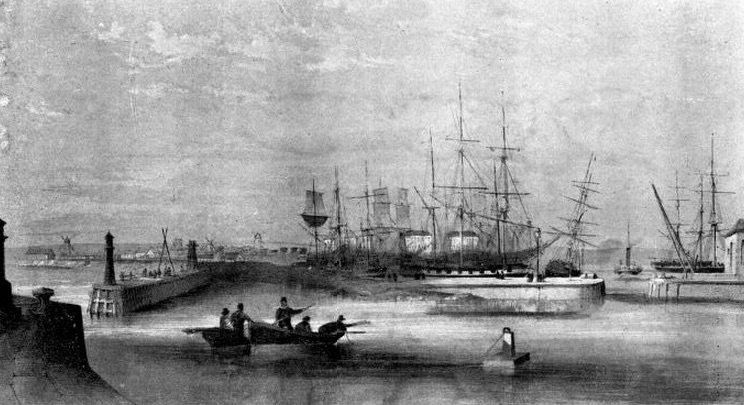
The West Hartlepool Harbour and Dock opened on 1st June 1847. Jackson Coal Dock opened 1st June 1852 and on the same day a railway opened connecting West Hartlepool with Leeds, Manchester and Liverpool. One of the first uses of the line was to carry fresh fish to the larger inland towns and cities, and presumable made it more convenient for our ancestors to make that journey. By 1881 Old Hartlepool’s population had grown from 993 to 12,361, but the newly born West Hartlepool now had a population of 28,000. By 1900 the two Hartlepool’s were one of the four busiest ports in the country and West Hartlepool alone had a population of 63,000. For many years West Hartlepool and Old Hartlepool were separate towns but merged together as one town under the Hartlepool Order of 1966.
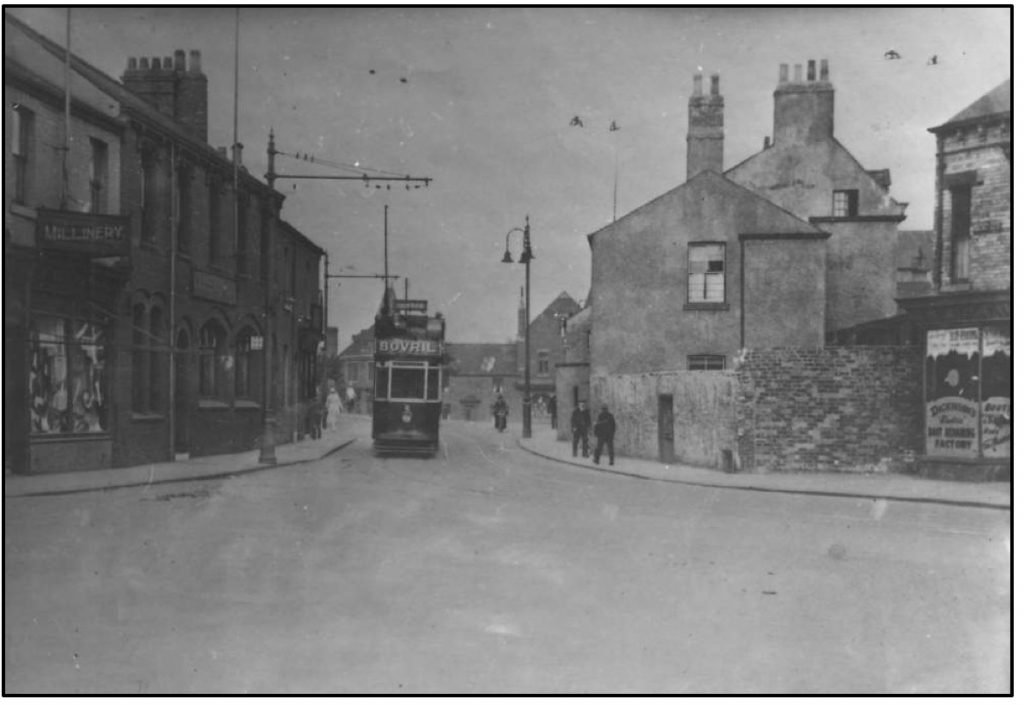
The Causeway Public House can be seen on the left.
So, what do we know around the arrival of the family in Hartlepool?
I think there is sufficient ‘evidence’ to suggest that at the age of 16 John became a merchant seamen in Hull, likely because of the family connections already in the town at that time as we have learnt. There doesn’t seem to be any other seamen in the family that he, or indeed William, might have taken a lead from. We also know that in the later part of the 1860’s three of the Summerfield families, also with connections to Hull, moved to the North East mainly to West Hartlepool. Jane was the sister of William and John’s father, and therefore their Aunt. She married James Mayoh in 1861 whilst living in Manchester, but by the 1871 Census they are living, along with James’s 63 year old mother, at 36 Albert Street in West Hartlepool. Another of the sisters Hannah, now Gregory, is living with her family, perhaps as little as two or three minutes away, at 21 Scarborough Street. This then would have been a very useful ‘familiar or home’ base for John and perhaps William in between their seafaring voyages, of which there was a huge potential in this very busy shipbuilding and shipping port. Hannah Mayoh was the daughter of the now deceased Mary, another sister of their fathers. This Hannah, also originally from Manchester and had lived in Drypool with her husband, had been in Sunderland from 1866 until she died there in 1868 aged just 29 years. Sadly, her husband William also died soon afterwards in 1869 whilst still living in Sunderland. The young couple left behind their three young children aged seven, four and three years. The youngest, John James Mayoh, is the young boy in the previous section who by 1871 was living back in Manchester with his Great Grandfather, John Summerfield, in the home of Johns’ daughter Margaret, yet another of the sisters. In 1871 the other two surviving children are residents of the Hartlepool Union Workhouse in Holdforth Road, Throston. Presumably they were in that particular workhouse, rather than one in Sunderland, because their closest relatives, Great Aunts Hannah and Jane, were living in the town. The eldest of the three children, Arthur, stayed in the area after the Workhouse, and worked, married and lived the rest of his life there. Mary Jane was adopted by John and Mary Houltby of Grimsby, Lincolnshire in 1881 but married and lived in Yorkshire most of her life.
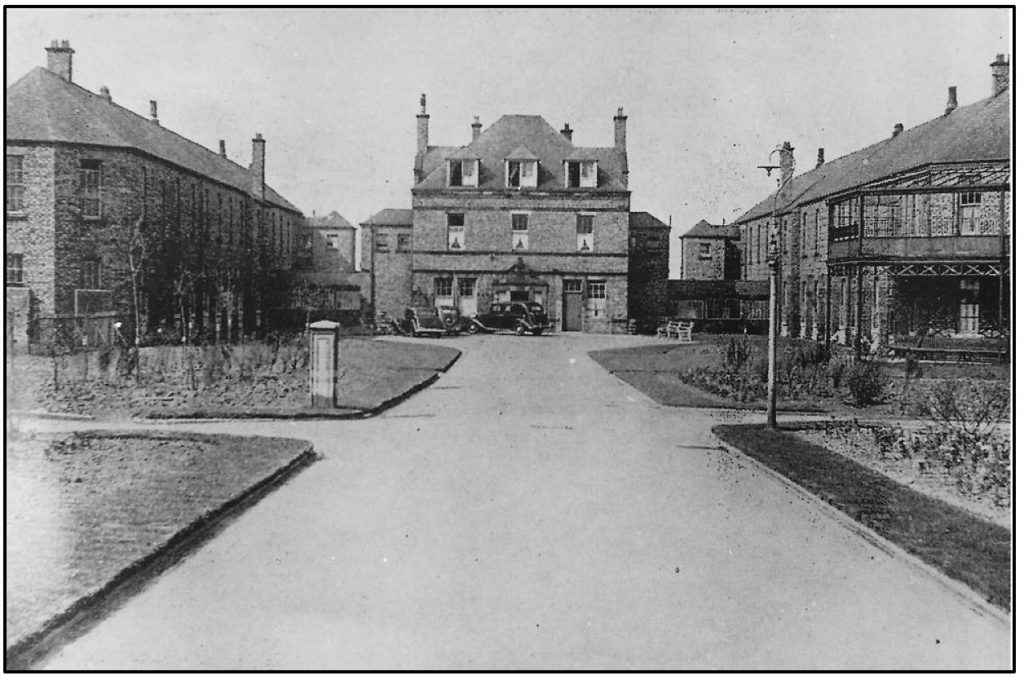
These buildings later became the Howbeck Infirmary and later again the Hartlepool General Hospital and interestingly your author George Michael Summerfield was born there in the early hours of 8th May 1947. So I suppose you could say that I was born in the Workhouse. I remember as a troublesome child quite often being told by my mother that I would drive her into Howbeck, which was an inappropriate phrase around that time referring to the fact that the Howbeck Infirmary had in its past contained a ward for mentally unstable patients (or as they were termed then ‘Lunatics’), and hence its other name ‘the Looney Bin’
Jane and husband James Mayoh at some point moved around the corner from Albert Street to live in Whitby Street, because that is where she died at 44 years old in 1877 of Nephritis Dropsy, which was a painful kidney disease. James married again later that year to Martha Clarke but then moved back to Manchester where they had a son in 1878, Job Joseph Mayoh.
Williams’ brother John married Elizabeth Jane Musgrave aged 20 on 10th January 1876 in Stranton All Saints church, West Hartlepool. Elizabeth was a proper ‘Old Hartlepool’ girl born and raised, her parents were originally from Sunderland and father was a Ships Carpenter so would have been away on voyages much of the time. By 1871 they were living at 23 Arthur Street, Stranton and were probably still there when Elizabeth married, the marriage certificate only mentions Stranton as her address. Important to our story with William and how loose connections might converge to provide future pathways, is the discovery that living next door at number 25 Arthur Street was William Laurie, and his family, a tailor originally from Scotland. They were sharing a house with Isabella Donkin and her family, and she is recorded in that census as being a Seaman’s Wife. The seafaring theme is very evident in all the streets around that area with perhaps as many as fifty percent being either at sea or connected to it. On his Marriage Certificate John is described as a bachelor, sailor, age 25, of Stranton, son of William Summerfield a Weaver. Their witnesses were William Foreman and Isabella Laurie. Isabella who would have been 21 was the eldest daughter of the neighboring Laurie family and William Foreman who was 26, lived with his wife a few streets away in 8 Andrews Place, and was like John a Mariner.
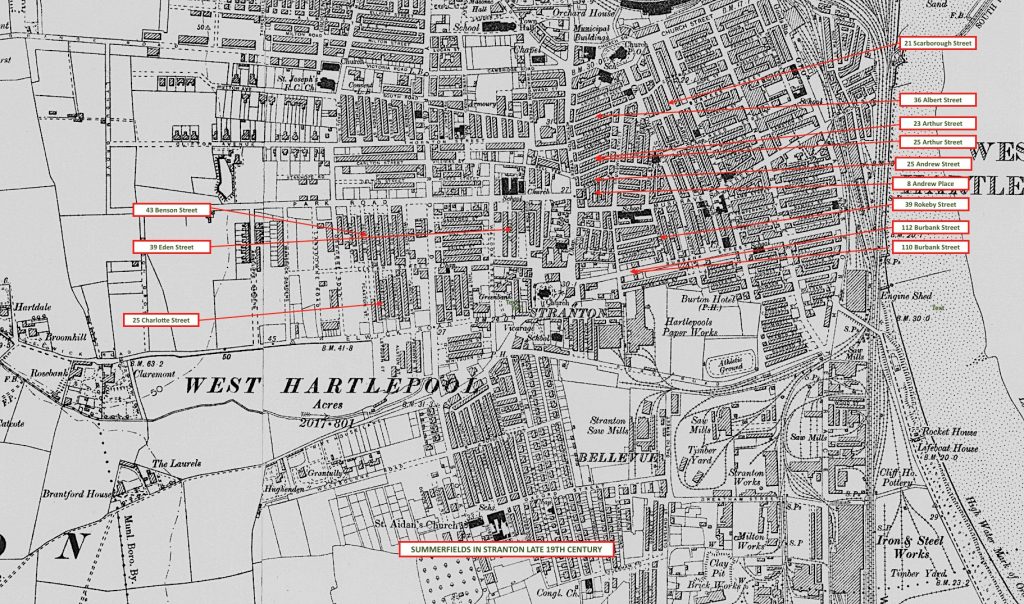
John and Elizabeth had eight children together, most born on the Sunderland area where they seemed to have settled from around 1882 and where he was employed as a Shipyard Driller. Sadly he died as a relatively young man of 43 in December 1893 of Heart Disease, they were living at 27 Lord Street, Jarrow. I couldn’t quite read the death certificate but there was something in the informant section about the Coroner, John Graham and an Inquest held the following day. Maybe the cause of death wasn’t readily apparent. His wife didn’t last much longer either, Elizabeth at 37 years old died 4th August 1894 at South Shields Union Workhouse, Harton Institution. Cause of death was Tubercular Phthisis Exhaustion, phthisis is another word for tuberculosis it was also called consumption, exhaustion perhaps means she coughed herself to death as that is one of the main symptoms of the illness but she also had the surviving seven children to look after on her own. The informant was E Read, Master, Union Workhouse, Harton.
What a disaster for the children, ranging in ages from 4 to 17 years. Elizabeth the eldest stayed around the same area, Alice ended up dying at 18 whilst in the Hartlepool Workhouse (her Aunt Tabitha Musgrave was the informant on the death certificate). Edith, William and Isabella ended up in Blackburn, Lancashire, I am assuming that this connection would have been through their fathers’ sister, Elisabeth, who after marrying Ambrose Walton back in Manchester had settled in Blackburn. They weren’t living with their aunt however, even if she had been instrumental in their relocation. In the 1901 census Edith and William are boarders with a family but no sign of Hannah or Isabella. Isabella does turn up in 1911 as a Domestic Servant in Blackburn. The youngest child Mary, only four when her mother died, I found living in Twywell, Northamptonshire by 1901. With two other similar aged young girls all from different places they were living with a widowed lady, so perhaps they were being fostered. It might, from the information available, seem that perhaps brother William could have done more to support the family at this devastating time, and perhaps he did. But the reality is that he and his wife at that time had six children of their own to support, and also had living with them Isabella’s mother Catherine and her son James.
So, back to the family trail and my Great Grandfather William. As already mentioned, apart from his birth in 1852 in Manchester I have been unable to find any trace of him even existing until the 1881 census and even that was a mixture of dogged research and good luck. It was here that we find him as a sailor but on board ship, the census details having been taken by the Captain, George Grantham, and later delivered to the Census regulators, which was the standard practice for ships at sea during a census at this time. On the day of the census the captain recorded the ship as being at coordinates 48°00’00.0″N 7°00’00.0″W. Which is in the Celtic Sea off the North West coast of France. The census also gave me the name of the ship on which William was sailing, the S.S. Minnie Irvine and a little bit of further research into this vessel uncovered some interesting and related details.
The ship was built in 1871/72 by Irvine & Co Ltd of West Hartlepool [another West Hartlepool connection]. The ship was approximately 220 feet in length and had two masts and was rigged as a schooner although the ship did have two engines made by Blair & Co of Stockton. The ship was retained by Irvine & Co and eventually sold to Norweigan owners in 1895. On the 19th January 1911 Minnie Irvine was sunk when in a collision with DREDGER No. 3 off the Ovens buoy, on the Thames, on passage from London to Hull in ballast, and was subsequently refloated, sold and broken up.
Although too late for an attempt to purchase the picture, I found these details in an online catalogue from Witton Auction Rooms, Wotton under Edge, United Kingdom. ‘This is an early 20th century gouache study of a Mediterranean marine scene with the SS Minnie Irvine off the coast with distant volcanoes, inscribed SS Minnie Irvine West Hartlepool, 43 x 64cm in birds eye maple frame.’ Realised: £30. Auction Date: 27th August 2008. I did try unsuccessfully to find the purchaser as I would have loved to own a painting of the ship my Great Grandfather had sailed in nearly 150 years ago.

But I have been able to find information on some of Williams’ voyages from records archived by the Maritime History Archive, in particular Crew Agreements, which were labour contracts between ship owners, masters and crew in the British Empire. For each voyage undertaken by a ship they listed every man and woman who worked aboard a merchant vessel. A large amount of information was written about every crew member, including his or her age, birthplace, job onboard and resulting wage. The Agreement was a legally binding contract on seafarers to remain with their vessel until officially discharged. It is interesting that because of these agreements we potentially have more documented information available on seafarers than any other of the population.
What I have been able to find out is that William was an AB, an Able Bodied Seaman, which would denote some years at sea but without any specific skill or trade training. Given the ports of call on these few voyages I would guess that they were engaged in the transportation of goods linked to the coal and steel making industries. These were some of his voyages:
On the 11th September 1880 William was working on the SS Renpro 67552 a ship registered in the port of West Hartlepool, the master of which was Mr RS Osbon of West Hartlepool. The voyage commenced in Newport, Wales, then onto Barrow in Furness and arriving in New York, USA on the 5th October. She called at Rotterdam, Holland, before terminating the voyage at Cardiff in Wales on the 22nd October. We also know from the Crew Agreement for this voyage that his monthly wage was £3.10s.0d, he was advanced £1.15s.0d with the balance of his wages £3.14s.4d paid on discharge. He must have then returned to West Hartlepool, I am assuming by now his place of residence, before joining his next ship the SS Annan 67534 on the 9th November. The master of this ship, which was also registered in West Hartlepool, was Mr TD Turner of Liverpool. This voyage starting in West Hartlepool took in Naples in Italy, Rouen in France, before terminating on 11th January 1881 in Newport, Wales. William transferred ships here joining the SS Minnie Irvine 67531 again having West Hartlepool as its port of registry and with Mr George Grantham of Yorkshire as its Master. They went to Salerno in Italy, Cartagena, Spain, terminating back in Cardiff on the 1st March. He then had another trip on the SS Minnie Irvine taking in Genoa, Italy and Cartagena before returning to Newport on 16th April. So, it would have been on this trip, 3rd April 1881 on their way back to Wales that the Master George Grantham took the census which included William Summerfield and allowed me to finally track down this elusive family member.
More 5/6 week trips followed visiting place such as Barcelona, Marsellies, Cartagena, Savona, Italy, and Carloforte, Sardinia, ending up once again in Cardiff. On this occasion William made a ‘Seamans Application for Advance and Railway Ticket Warrant’ with the destination of West Hartlepool. The cost of the advanced ticket was £1.3s.10d and he also had a cash advance of ten bob (£0.10s.0d) obviously for costs on the journey.
Just a few days after finishing this voyage in Cardiff, William was getting married to Isabella, probably why he had invested in a Railway Warrant, to make sure that he was back at West Hartlepool in time for the wedding. They married on the 24th October 1881 at All Saints Church, Stranton. William’s father, William, is recorded as being a Labourer and Isabella’s father as being a Tailor, the couple both give Stranton as their place of residence. The witnesses were Isabella’s brother William and her sister Margaret Leitch Laurie. I have pondered why William wouldn’t have had his brother John as his ‘Best Man’. John was living with his family in Sunderland, although from the records it seems his wife came back to Hartlepool to have two of her children in 1880 and 1881, most likely staying with her mother in Silver Street, Stranton. William’s wedding was on a Monday, so would have meant a day off work for John and they did have three small children, all the same your brother’s marriage is something you usually would make a special effort for.
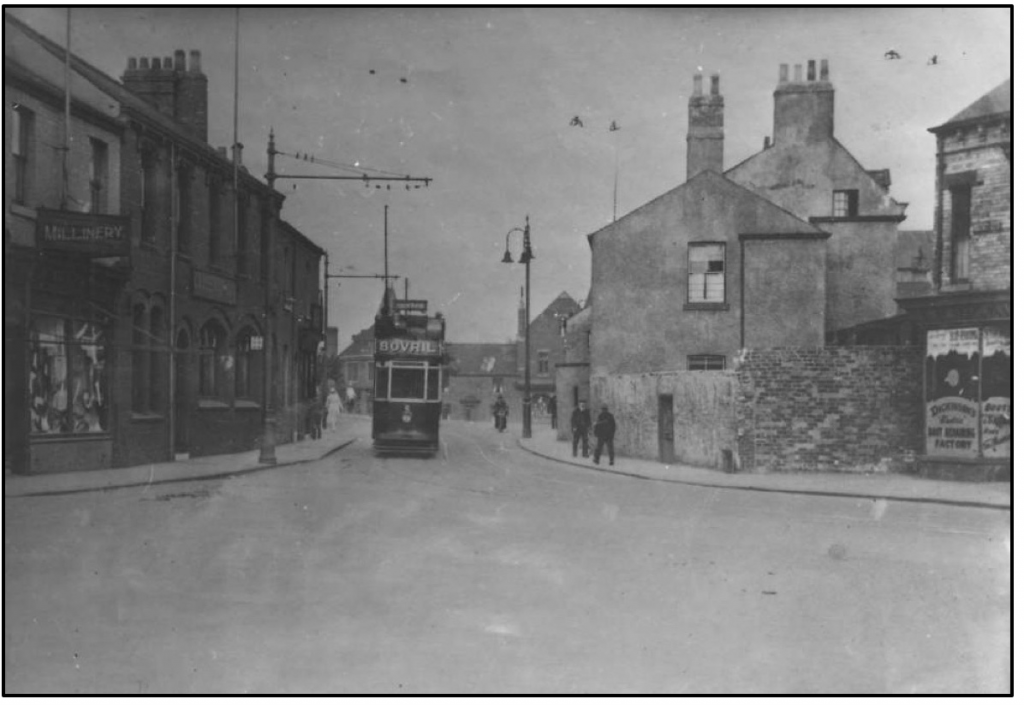
The Causeway Public House can be seen on the left.
Although William did go back to sea he was certainly a landlubber by the time son William was born in 1882 with his occupation showing as a General Labourer, and their address is 112 Burbank Street. By 1884 and the birth of Catherine he was still showing as a General Labourer although for some reason they had moved next door from 112 to 110 Burbank Street. Just eighteen months later he is recorded as a Mariner on his son John’s Birth Certificate in 1885, and the family was living at 25 Charlotte Street. By the time of the Census in April 1891 he described himself as a Labourer, Retired Mariner and they had moved to 39 Rokeby Street. Ten years on to the 1901 Census he is now a Public House Barman and had moved to 39 Eden Street, where he was to live until his death in 1929 that’s 28 years in the same house and it was probably rented. In 1911, which at the time of writing was the last available Census, and at nearly 60 years old we have him with the unusual occupation of Lamplighter. Lamplighters were employees of the town or city. Early street lights were generally candles or oil that required someone to light a flame each night. It was the lamplighter’s job to ensure the street lights were lit each evening and extinguished when daylight approached. As electricity became more and more common, lamplighters became rare and eventually faded out of existence. Interestingly this occupation would have fitted in quite well with the window cleaning business that his sons John and Robert had at the same time. Similar equipment that could be shared as it would be needed at different times of the day.
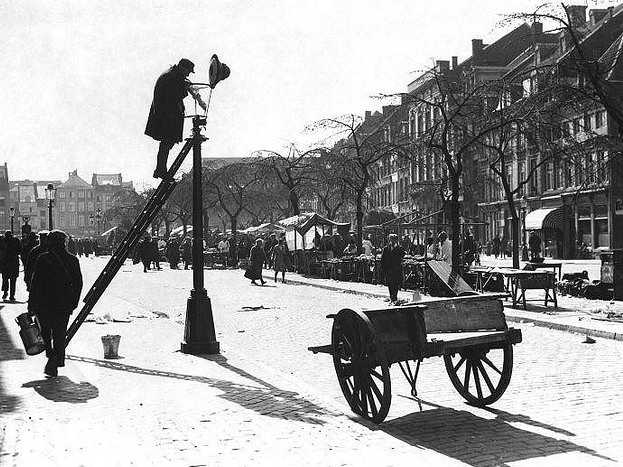
William died aged 76 at home on 8th June 1929 having outlived his wife Isabella by fifteen years. His death was reported by the wife of his son John (she was my Nana Summerfield) and living just down the street at number 18. He was recorded as being a Retired Dock Gateman and the reasons given for his death were Auricular Fibrillation and Myocarditis. He had also outlived two of his grown up sons, John (my Grandfather although we never met) who died in Russia in 1919 during the First World War and Robert who died in 1926.
The children of William and Isabella.
One of the questions I have pondered during my family research was why most of the siblings of my grandfather made the move to Canada and in particular settled in Guelph, Wellington, Ontario. The broader view is of course that during the late 19th and early 20th century there was a massive period of emigration from Britain to Canada in general and Ontario in particular and Guelph was one of many rapidly growing locations. So, for me, the real answer is that the first loosely connected family member made their destination choice for whatever that may have been, and later immigrants then probably followed that path because of the connections and familiarity.
Here is what I have discovered.
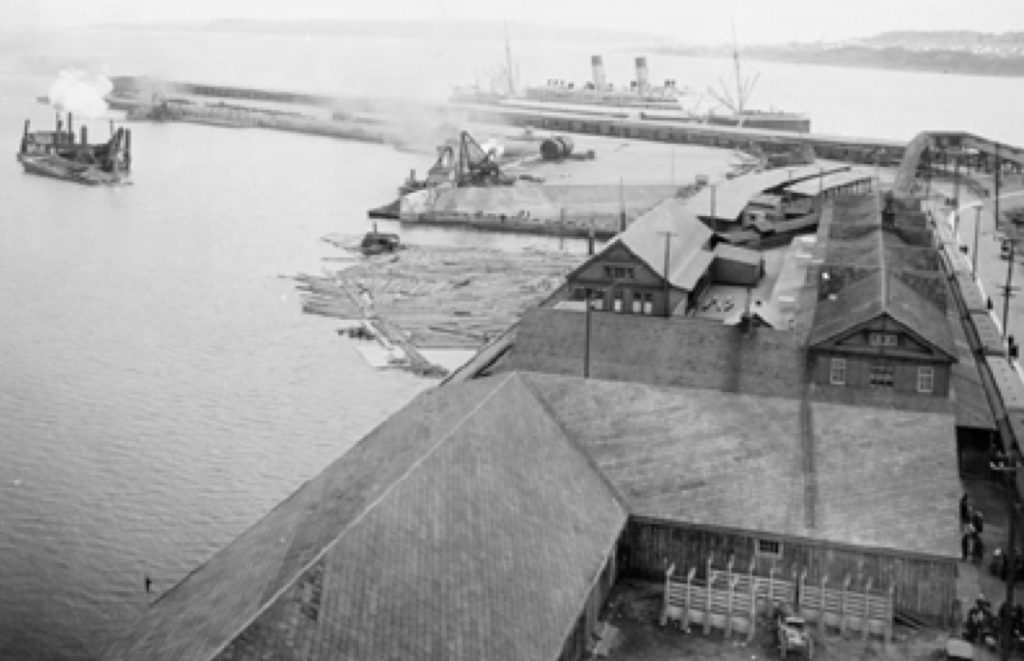
Pictured here are Montreal’s immigration sheds, where thousands of newcomers would be counselled, accommodated and fed during the nineteenth and early twentieth centuries. This photograph was taken in 1911, shortly after a series of improvements had been completed on the facilities. Source: Library and Archives Canada/PA-178439.
Catherine Summerfield born 1884 in West Hartlepool.
The first of our direct line to make the journey would appear to be Catherine, the older sister of my Grandfather John Summerfield, born in 1884 in West Hartlepool and the eldest daughter of William and Isabella. She travelled out on the 7th October 1907 heading for the City of Guelph, South Wellington, Ontario, with the reason given for emigration being ‘to get married’. Her husband to be was William Langley who had travelled out on 21st June 1907, and they married on the 14th October 1907, within days of her arriving.
William was born in Boroughbridge, Yorkshire in 1884 and son of an Engine Driver. He turns up in the 1901 English Census at 17 years old living with his sister Rhoda at 15 Gordon Street, West Hartlepool, their family still back in Boroughbridge so obviously striking it out on their own. His occupation was listed as a Belt Maker in Engine Works, which probably would have been the Central Marine Engine Works (CMEW) in Middleton Road. One of my friends from school served his apprenticeship there so I visited the place occasionally in the early sixties. Interestingly, William and Rhoda’s next-door neighbour in Gordon Street, Harry Kirk, was like his father an Engine Driver, also from Yorkshire, so maybe a connection there. I am guessing that with William and Catherine being roughly the same age they must have become a couple in the six years leading up to their emigration, probably on an assisted passage, in 1907 and subsequent marriage.
They were married by licence in Guelph on the 14th October 1907, and William’s occupation is recorded as being a Machinist and the maiden name of his mother as Lanin. Intriguingly the maiden name of Catherine’s mother is given as Emma Foster not Isabella Laurie. Unfortunately, I think this is going to become one of those family history mysteries because I can find nor offer any evidence as to why this would be recorded this way. I have researched extensively the name of Emma Foster back at the time of Catherine’s birth and cannot find anything that would link them, and her birth certificate records both William Summerfield as her father and Isabella as her mother. Speculation can run amok, but there is no further information.
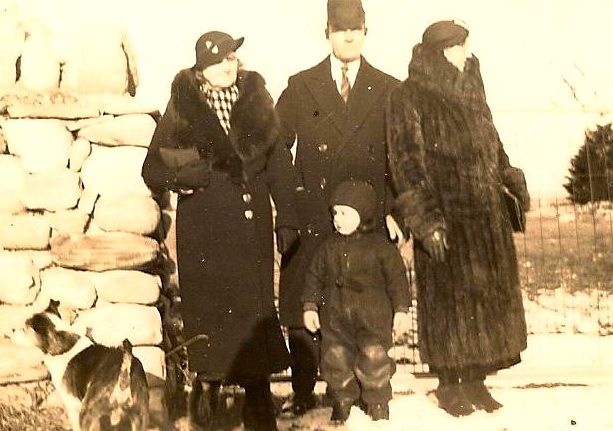
This old photo is the earliest I have for Catherine, or Ciss as she seems to be called by the family. The handwritten note on the back reads, “Aunty Ciss, Uncle Bill, Aunty Sarah & George”. This then dates the picture, because George would be my father who was born May 1907 and looks to be a little over one year old, so, given the clothing perhaps late 1908. The picture probably taken by my grandmother Sarah, who would still be Lee at that time, but describing the siblings of the man she would marry in 1911, John Summerfield, as Aunty and Uncle, but that could be because it was annotated later in life. The two families, who both lived in Eden Street, were obviously close even before the marriage between John and Sarah. But there are inconsistencies with this dating model because Ciss or Catherine had already emigrated and was married in Canada in October 1907. I couldn’t find information of a sea crossing back, but that doesn’t mean that there wasn’t one. Also, William would have been 26 but looks older in the photograph, and Sarah would have been just 13/14. The Sarah in the photo looks a lot older than that. Bit of a mystery.
By the time of the 1911 Canadian Census in May/June William and Catherine were living at 61 Tiffany Street in Guelph, and William was working as a Polisher at a Stone Works. Also living with them was Catherine’s brothers William and John. William had been out there since 1908 according to the Census and John just that same year, both recorded as Labourers. I have William on a passenger list 11th June 1909, which is more likely and John 2nd June 1911, which in itself is a little strange as he had only been married for a couple of weeks.
Catherine, now Langley of course, made the trip back to England 14th June 1912 and returned to Guelph with her sister Isabella on 13th September the same year, and who married Earnest Arthur Henson, also an English immigrant, in Guelph June 1915.
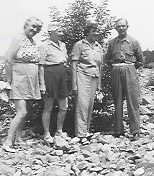
This picture has the notes on the back, “Aunt Ciss Uncle Will a friend & myself. Taken at the Beach this is a rock beach the other side is sand”. The handwriting is the same as on the earlier photo and the detailed, almost personal, description of the beach makes me think that it is Sarah again. It would be Sarah next to William, then Catherine and on the far left the friend. This is difficult to date, but judging by apparent ages, which can be a lottery, I would put it at around the early 1920’s perhaps, after her son, my father, had listed in the regular army aged 16. I am not aware of my grandmother Sarah ever making the trip out to Canada but she easily could have done, significant events in the preceding few years to bring them together would have been, brother John and Sarah’s marriage in 1911, Mother Isabella’s death in 1914 and John’s untimely death at the end of WWI in 1919.
We have Catherine and William living at 414 Eramosa Road in 1920, and also making a trip to the USA arriving at Detroit, Michigan in April 1920. William had his occupation on the Immigration Form as a Millwright. Sadly, he died in a drowning incident 15th July 1934, they were at that time living at 20 Harris Street, Guelph. The location of the drowning incident was Tiverton, Bruce County, which is about a two-hour drive from Guelph City, and looks like it could be a beach holiday destination. An assumption I think confirmed by the fact recorded on the death certificate that they had only been there for the day. Very sad and how distressing this would have been for Catherine, I wonder if any other members of the family were with them. It looks like after her husbands death Catherine moved up Harris Street from number 20 to live with her brother William and sister Sarah who had emigrated to Guelph in 1926, at number 77. Another sad coincidence was that the day after William being drowned, Lois Martha Cross, daughter of Ernest Henson’s sister Catherine was being married. One would imagine that originally all would have been invited to the wedding. The Cross family were back living at that time in number 37 Norwich Street, you will see later how often that street crops up in this family history.
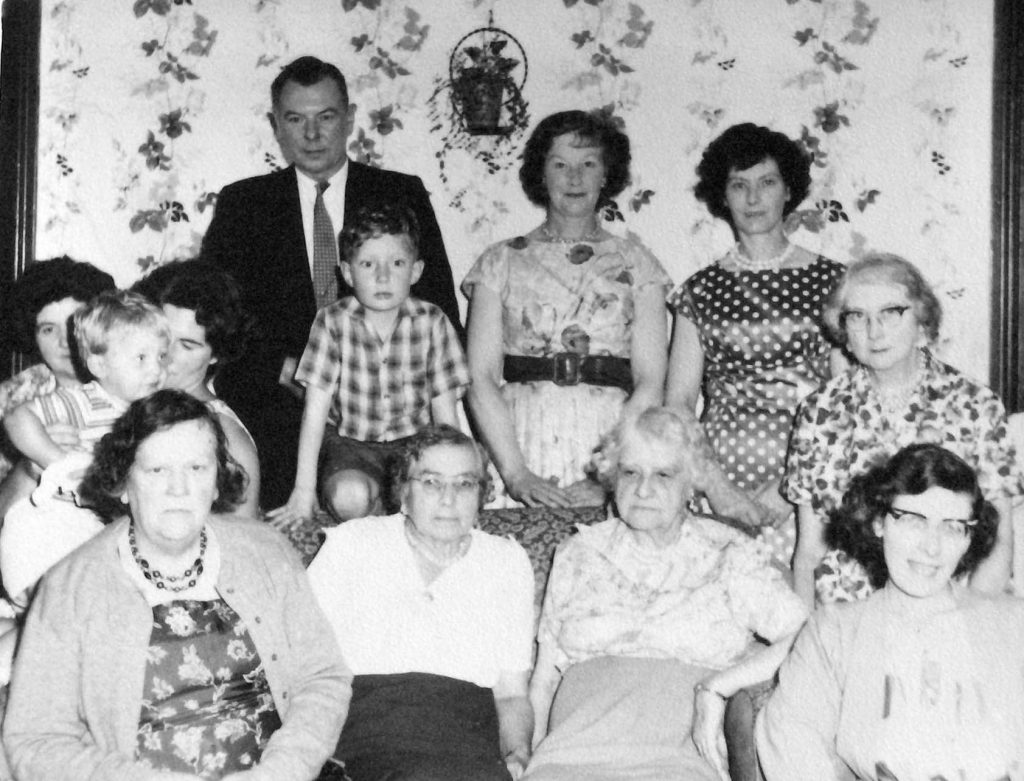
The picture above would have been taken in the summer of 1961 at 21 Colenso Street where Nana Summerfield (bottom row end left) lived with her daughter Sadie Potter (back row end right) and her son Bryan. Daughter Bella Ingram (bottom row right end) lived next door with her family including youngest son Tony (back row 2nd left). Third daughter Kitty Coates is next to my dad (back row left end). My mother is with my sister Sheila and her son Phillip (middle row left end). I would have been about 14 and still at school. That leaves the three Great Aunts, which I think is Isabella Henson (middle row right end) who had just made the trip the previous year with husband Ernest, Sarah next to Nana Summerfield and Catherine Langley next to her.
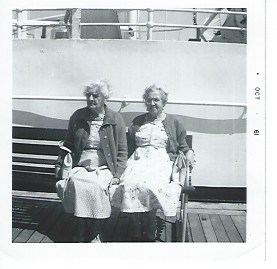
This photo which has a date stamp on the front of Oct 61, so would have been on the return crossing, and the note on the back “taken on the Empress of Canada”. This would be of Catherine on the right and Sarah on the left so photo would probably have been taken by Isabella
Empress of Canada was planned for the transatlantic route from Liverpool to Canada for the Canadian Pacific Line. She was a slightly enlarged sister ship and running mate for Empress of Britain and Empress of England on the route from Liverpool to Montreal. During the months that the St Lawrence was frozen (typically November to April) the ships sailed from Liverpool to St John, New Brunswick.
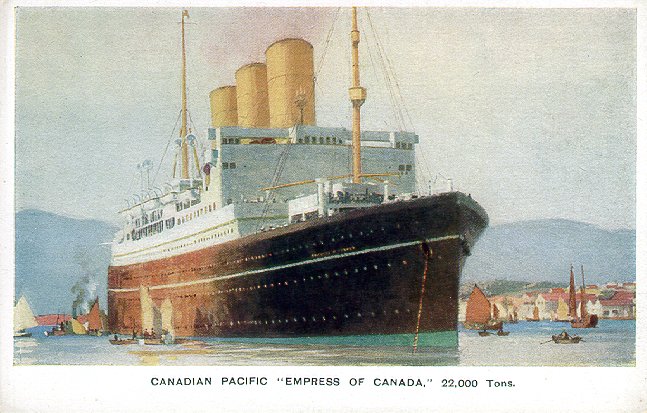
The last event I could find for Catherine was the 1965 Canadian Voters List, now aged 81 living with Sarah, 70, but no William Summerfield, at 149 York Road.
William Summerfield born 1882 in West Hartlepool.
The next sibling to make the trip to Canada was William a Bricklayer. He travelled out for the first time in June 1909 at 26 years old, heading to Guelph to live with his sister Catherine and her husband. By the time of the 1911 Canadian Census they were living at 61 Tiffany Street and had been joined by his younger brother John. William must have returned home to England sometime shortly after that Census because I have him returning to Canada in May 1913 for what must have been just a holiday because he returned to England again in December 1913. While back in England The Great War broke out and like his brother John he enlisted with the Durham Light Infantry. I was unable to find any Service Records for him, perhaps not surprising as something like 60% were destroyed during the Blitz in WWII, but did find an entry in the British WWI Medal Rolls Index Cards which provided this information;
Regiment: Durham LI 9th Battalion. Regiment Number: 6571. Private.
Enlistment 22.8.1916. Discharge 21 4 1917. Cause of discharge. Para 392 XVI KR Sickness. Action Taken List T.O. 650
A Guide to WWI Causes of Discharge – Paragraph 392 of King’s Regulations 1912 informs that there are twenty-nine different ways in which someone could have been discharged under the King’s Regulations. The XVI KR in his record stands for King’s Regulations, section twenty-one. The different regulations include; (xvi) No longer physically fit for war service.
This is just speculation but there does seem to be some correlation between the three brothers regarding illness with a susceptibility to lung disease being a theme. The scant details we have for William doesn’t tell us what the ‘sickness’ was that made him ‘no longer fit for war service’, but John died at the end of the war, not through injury but Bronchopneumonia, and Robert dies early in 1926 with Pulmonary Tuberculosis.
William returned once more to Canada this time to settle in June 1923. I know that he lived with Sarah and Catherine at Harris Street and York Road between 1940 and 1957 but no information after that, presumably he died.
John Summerfield born 1885 in West Hartlepool.
John married my Grandmother Sarah Lee, who already had a four-year-old child, my father George William, on 15th May 1911. There is a complete chapter recording John’s short and turbulent life, but in the context of Canada I was a little surprised to find that he also had made the transatlantic journey. Even more surprised that after marrying on 15th May in 1911 he was by 2nd June a passenger on the ‘Virginian’ heading for Guelph. Not only the fact that he left within days of getting married but then stayed in Canada for another year until June 1912. While he was in Canada he worked as a Labourer and boarded, along with his brother William, at the home of Catherine and William Langley at 61 Tiffany Street.
Isabella Summerfield born 1893 in West Hartlepool.
Unlike her sister Catherine who emigrated to Canada in 1907 specifically to reunite with her boyfriend/ Fiancé from England and marry him, Isabella seems to have made the trip at 19 years old in 1912 to pursue a fresh start. She travelled to Canada with Catherine, who had travelled back to England with her brother John arriving in Liverpool 1st June 1912, probably to specifically accompany Isabella on the journey back to Canada which happened in September that same year.
I doubt that Isabella would have been aware at that time but her future husband, Ernest Arthur Henson from Nottingham, also made that transatlantic journey and also destined for Guelph, just a month earlier in August. I have decided to record further information related to Ernest’s life journey as well as the transatlantic one, as much to highlight how the couple ended up together but also to make the extended family connection with one of Guelph’s early politicians, Samuel Carter.

Samuel Carter (December 8, 1859 – June 16, 1944) was an Ontario manufacturer and political figure. He represented Wellington South in the Legislative Assembly of Ontario from 1914 to 1919 as a Liberal-Prohibitionist member. He was born in Ruddington, Nottinghamshire, the son of Samuel Carter and emigrated to Canada West in 1880 at just 21. He owned a knitting mill. Carter served as mayor of Guelph from 1913 to 1914. He was vice-president of the Hydro-Electric Union and chairman of the Heat and Light Commission for the city. He was also president of the Workingman’s Co-operative Association of Guelph. In 1909, he became the first president of the Co-operative Union of Canada serving until 1921 and was an influential member of the local Methodist community. Carter was also an unsuccessful candidate for a seat in the federal parliament in 1921. He died at his home in Guelph in 1944.

His success has been an important factor in our family’s settlement in Guelph. As a new immigrant, Carter established a knitting factory at 60 Manitoba Street in 1882/83 employing seven or eight people in the manufacture of gloves, mitts, and hosiery, etc. The knitting factory was the forerunner to the Royal Knitting Company in 1893 with a factory located at 41 Norwich Street at the south-west corner of Cardigan and Norwich Streets and employed around 75 – 80 workers by 1908. His residence at that time was at 76 Cross Street. Samuel had been involved in the knitwear industry all his life and his father had been a Framework Knitter before he was born. Ruddington’s association with the knitting industry had begun by the start of the 19th century after the invention of the Knitting Frame in Nottinghamshire. The industry attracted new inhabitants and the population grew to 2,500 during this time as an associated extension to Lace manufacture. The 1851 census showed that half of the heads of households in the village were involved in the occupation. Framework knitting in the village declined towards the end of the 19th century as steam-powered machines developed and factories provided large-scale competition to the manual methods still being employed by the villagers. Perhaps the reason why Samuel decided to try his luck abroad.
My tenuous relationship to Samuel Carter looks something like this:
Great-Aunt’s Brother-in-Law’s Uncle.
George Michael Summerfield – Me
George William Summerfield – My father
John Summerfield – His Father (actually step father)
Isabella Summerfield – His sister
Ernest Arthur Henson – Her husband
Catherine (Kate) Elizabeth Henson – His sister
Ernest William Cross – Her husband
Ada Carter – His mother
Samuel Carter – her brother
Catherine E Henson born 25th Aug 1889 in Basford, Nottinghamshire, was the sister of Ernest Arthur Henson, born 21st Dec 1891 in Ruddington. Ernest went on to marry Isabella Summerfield, my grandfather’s sister, born 1st Mar 1893 in West Hartlepool, Durham. Catherine married Ernest William Cross, born 18th May 1886 in Ruddington, on 28th Dec 1909, and they emigrated with daughter Dorothy, Ernest’s mother Ada, his sister Gladys and brother Frederick. They all sailed on the ‘Virginian’ heading for Guelph 21st October 1910. Six months later in the 1911 Canadian Census, Ernest, Catherine, Mary and Frederick were all living at 37 Norwich Street, but mother Ada had returned to England. The dates and address are important because they had moved in to a property just two doors down from the newly opened factory of the Royal Knitting Company run by Ada’s brother Samuel Carter. Also living virtually next door to them, at number 47, was Samuel and Ada’s younger brother Herbert and family, all knitwear workers from Ruddington and also all working for Samuel.
But let’s get back to Ernest Arthur Henson, Catherine Henson/ Cross’s younger brother. In 1912 on 10th February at 20 years of age at Seaforth near Nottingham he enlisted in the regular army for a 12-year service with the 3rd Dragoon Guards Regiment, Corps of Dragoons of the Line. Disappointingly by the 10th of April he was being discharged. He was discharged at the Western Cavalry Depot under para 390 (v) of the King’s Regulations. These set out the various reasons (causes, and there are many listed) for which a soldier could be discharged. In Ernest’s case that having claimed the ‘Discharge on payment of 10 shillings within three months after his attestation— At home and abroad’. I think this means that within 3 months of his attestation he could request discharge on the payment of the ten shillings. It would seem that he discovered army life was not going to be to his liking and the family bailed him out with the payment. On his attestation paperwork he had recorded his occupation as a farm labourer, not in the textile industry like his extended family and most of Ruddington village. But we know that the industry had been in decline from the turn of the century so his prospects were probably limited. With Ada Cross recently returned from Canada with perhaps upbeat stories of the opportunities there his plans may have taken a new direction. Whatever the reason by August that year he was travelling out to Canada to live with his sister and her family at 37 Norwich Street.
The connection to Isabella Summerfield has to be speculation because to the best of my knowledge there were no other connections between the family and that of Carter, Cross, Henson families. But here are a couple of suggestions, Isabella living at 61 Tiffany Street was just a short walk from Ernest at 37 Norwich Street. Same age, and young, new arrivals, both from England, there may well have been social opportunities for them to meet. Also, on their marriage certificate in 1915 Ernest has recorded his occupation as a Polisher. We also know that from the 1911 Canadian census that William Langley had an occupation as a Polisher at a Stone Works, so perhaps this was the connection between them, that Ernest and William had worked together. Whatever the actual connection it resulted in them being married on the 7th June 1915. Isabella was then 22 and Ernest 23 and their first witness to the marriage was Minnie Adeline Hambridge who lived next door to Isabella at number 62 Tiffany Street and also of a similar age.
In 1920 they are living at 60 Arthur Street and still there in the 1921 Census along with their son Roy W born in Quarter 4 of 1918. In July 1922 Isabella took Roy home to England for a six-month holiday, staying whilst they were there at 39 Eden Street with her father who would be 70 in December of that year. Her mother Isabella had of course already died, back in 1914, but brother Robert would still be living there as well as sister Sarah. Sarah’s sister, Elizabeth, now Westgarth, living a 20-minute walk away in Marlborough Street. Isabella returned to Guelph with Roy via the winter crossing port of St John, New Brunswick, in December.
By 1923 they were all living at 33 Norwich Street and still at that address in 1926 when Isabella went back to England again and returned with sister Sarah who also made the decision to settle in Canada. Sarah must have been living with her sister in law Sarah Lee/ Summerfield, my Grandmother, at 18 Eden Street, because that is the address given on her sailing documents. Their brother Robert, who had been living with his father William at 30 Eden Street, had died in January 1926 of Pulmonary Tuberculosis and Syncope at just 37. Perhaps she moved out when Robert died, perhaps she lived with the widowed Sarah to help with the girls aged around 13, 11 and 8. Their brother, George 19, my father, was by then in the regular army in India. With Sarah the last of his daughters gone it looks like the 73 year old William was left living on his own for he was still at number 39 when he died three years later.
In 1935 Ernest is now a Fireman and living with Isabella at 124 Ferguson Street, by 1940 still at same address Ernest still a Fireman and son Roy W, now about 22, a labourer. In 1949 Roy W had moved on and Ernest and Isabella had moved a few doors up the street to number 129. In 1953 Ernest is recorded as an Engineer and living with Isabella at 94 Quebec Street, their son Roy, working on the Railroad and living with wife Evelyn at 304 Exhibition Street where they stayed at least until 1974 working as a Conductor on Canadian Pacific Railway. They had a son Brian who is first recorded in the Voters Lists that year as a Student living with parents.
By 1957 Ernest is retired and he and Isabella have returned once more to Norwich Street this time living at number 47, but a year later for some reason they have moved in with sisters Catherine and Sarah at 149 York Road. Brother William who had been living with Catherine and Sarah had recently died so perhaps there was enough room in the house for the Henson’s as well. In 1960, Ernest and Isabella now both 67, made a crossing on the’ Empress of England’ back to Hartlepool, perhaps a first visit for Ernest, their place of residence during their stay was with Mrs R Moyle, 9 Chatham Road. This was an interesting discovery for me because although I have not been able to identify who the Moyle connection might be, at that time I would have been thirteen and living with my parents at number 77, Isabella of course would have been my father’s aunt. I do have a vague memory from about this time of being told about a visit of my great aunt from Canada, and can particularly remember being given a ballpoint pen with a picture of an Oceangoing Liner on it in a gift box, presumably bought on board on their journey over.
Back in Guelph in 1963 they were living on their own again at 25 Grove Street, but from 1965 until 1972 also had staying there Dorothy McNaughton, Widow and Miss Virna Reynolds, Dietician, probably lodgers. I am guessing that by 1974 both Catherine and Ernest had passed away because Isabella at 81 is living with Sarah 79 at 149 York Road.
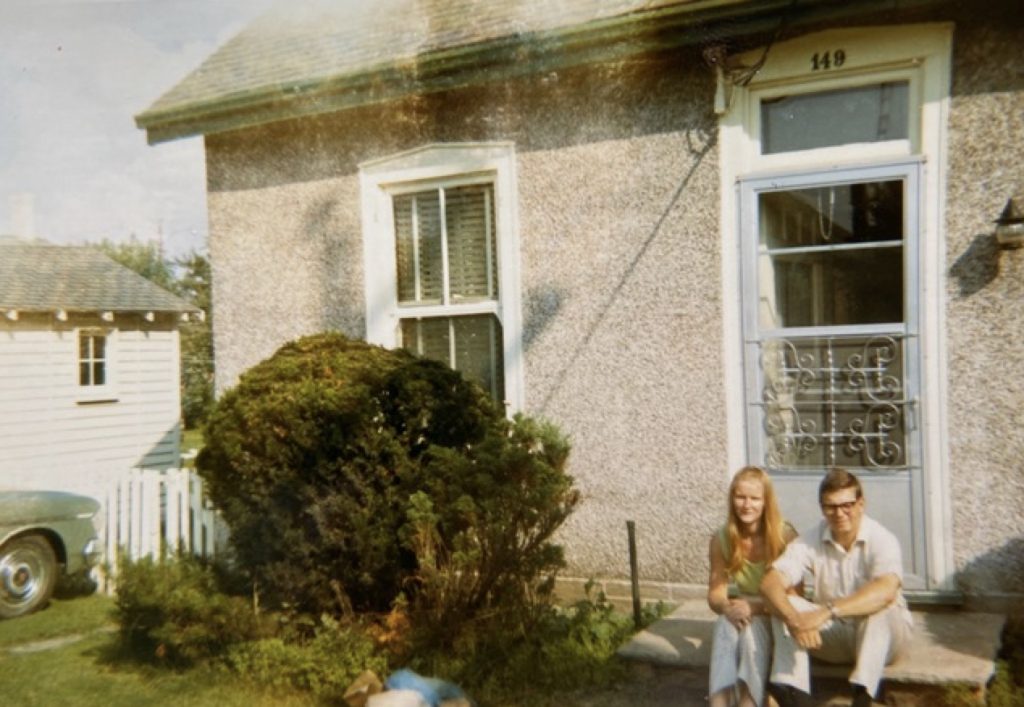

I was given this picture by my cousin Bryan Potter from his mothers’ collection. It shows the three sisters together dated I would guess late 50’s early 60’, on the back of the photo it says that the picture was taken at the cottage. Bryan told me that when he and his wife Susan quit their jobs in Nova Scotia in 1970, they drove across Canada to Calgary, Alberta, and stayed at Great Aunt Sarah’s house in Guelph. They were there for about two weeks, and Nana Summerfield and his Mum, Sadie, made the trip from England to Guelph to visit with everyone. One of the excursions they did was to the family’s cottage north of Guelph, by a lake and that this looks like that cottage. It was likely to have been on Georgian Bay or the slightly closer Lake Huron. Earlier in this section I informed that Catherine (Ciss)’s husband William Langley died in a drowning incident 15th July 1934. The location of the drowning incident was Tiverton, Bruce County, which is about a two-hour drive north from Guelph City, and looks like it could be a beach holiday destination. Tiverton is actually on Lake Huron but the same body of water as Georgian Bay. All speculation of course.
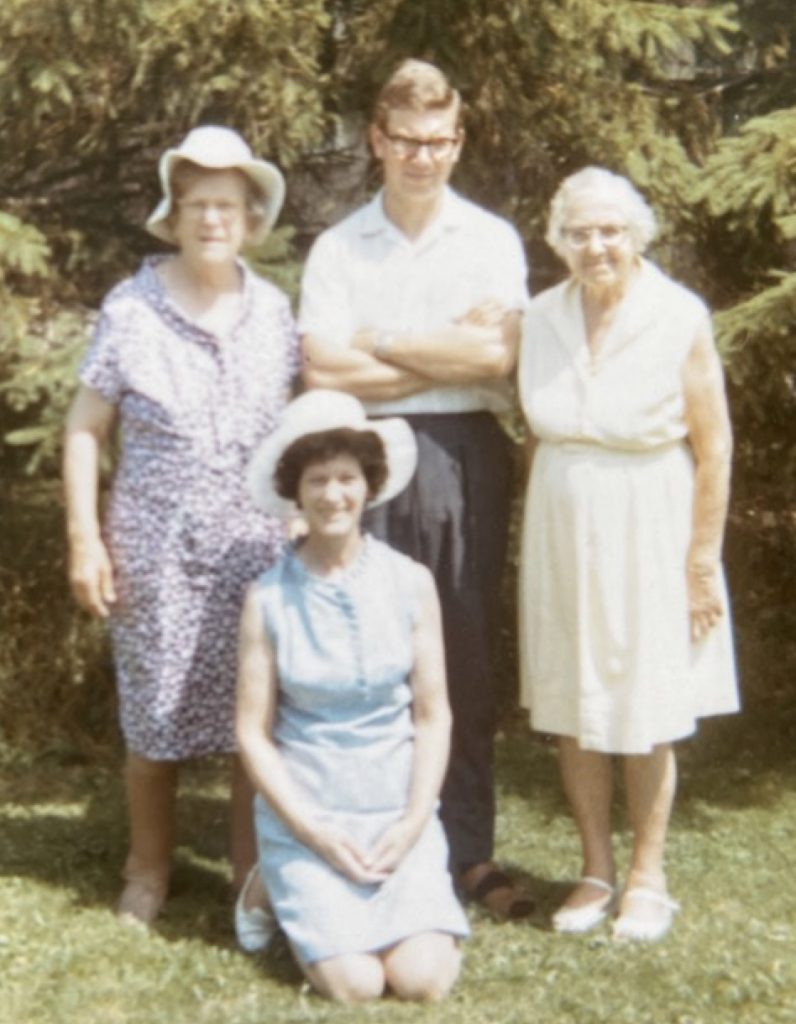
Sarah Summerfield born 1895 in West Hartlepool.
The stories of Isabella and her husband Ernest, brother William and sister Catherine start to merge after Sarah’s arrival. We know that William Langley, Catherine’s husband died in that tragic drowning incident in 1934 and by the following year Sarah is sharing 43 Alma Street South with Catherine and brother William. William and Sarah a Knitter and probably working at the Royal Knitting Company in Norwich Street, about a 30-minute walk away. By 1940 the three siblings were still living together but had moved to 77 Harris Street which was a couple of streets away from where sister Isabella was living at 124 Ferguson Street. The family is sticking together. They stayed in Harris Street until 1953 after which they moved just a short distance to 119 York Road. A few years later in 1957 there is no William presumably he had died, he would have been 75 by then, and the two sisters had moved two minutes up the road to number 149. One year later Ernest, now retired, and Isabella had moved in with them at 149 York Road. Sarah continued living in that house probably until she died but certainly still there in 1974. I don’t think the Hensons would have stayed at 149 for very long and after Ernest died, sometime between 1972 and 74 Isabella who was 81 moved back in with Sarah, now 79. Catherine had already died, she wasn’t on the trip to England in 1969, so sometime in the previous couple of years, she would have been around 84.
ooooo00000O00000ooooo
The William Leitch Laurie Story
I came across this family related story during my research, and although it is not about a direct family member there are a number of connections and I didn’t want to lose the story, so have added it here with the other Hartlepool families.
William Summerfield (1852 – 1929) married Isabella Laurie (1855 – 1914), Isabella’s brother James Leitch Laurie (1871 – 1942) was the father of William Leitch Laurie (1906 – 1979). James Leitch Laurie and his widowed mother Catherine were boarding at 15 Rokeby Street just down the road from William and Isabella Summerfield at 39 Rokeby Street in the 1891 Census. In the 1901 Census James and his mother are living with William and Isabella, but now at 39 Eden Street.
In the newspaper article below it says that WLL had attended Lister Street school, which my father also did. WLL was born in 1906 my dad in 1907. WLL living in Marske Street and my dad in Eden Street all very close together, so WLL would have been in the year above but loosely connected through my Dad’s grandmother Isabella Laurie and they almost certainly would have known each other.
WLL continued his Merchant Navy career after the war and apparently when in Canada would go and stay with the Summerfields. These would have been some of Isabella Laurie and William Summerfield’s children. In the years after the war there would have been four out there in Guelph, Ontario, not too far from Toronto. The three girls , Isabella, Catherine and Sarah and the brother William, two of the girls were married out there, Sarah and William never did.
Hartlepool Northern Daily Mail – Tuesday 23 May 1944
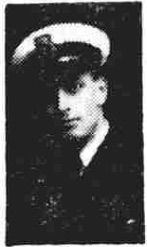
AWARDED ORDER OF RED STAR Chief Engineer Wilfred Laurie, of 3 Coast Road, Blackhall has been awarded the Order of the Red Star Marshal Stalin for gallantry and devotion to duty while in convoy to North Russia. Mr. Laurie is the husband of Nurse Laurie, better known in the colliery district as Nurse Blair, and the son of Mrs. J. Laurie, of 5 Marske Street, West Hartlepool. Aged 38 attended Lister St. School, and served his apprenticeship at the C.M.E.W. He has been at sea almost continuously since the war began, and is no stranger to the North Russia run.
- First Name: Wilfred Leitch
- Surname: Laurie
- Rank: Second Engineer
- Gazette Date: 11/04/1944
- Campaign Medals:
As with most Armed Forces Serving Personnel during the conflict of World War Two, Wilfred Leitch Laurie was entitled to the War Medal 1939-1945. This medal was awarded to all full time service personnel who had completed 28 days service between 3rd September 1939 and the 2nd September 1945. Eligible personnel who had been “Mentioned In Despatches” during the War were entitled to wear a bronze oak leaf emblem on the ribbon. Those eligible for a campaign star, yet who had their service cut short by death, wounds or capture by the enemy, still qualified for this medal. Wilfred Leitch Laurie was awarded the 1939-45 Star for operational Service in the Second World War between 3rd September 1939, and 2nd September 1945.
- Service: Merchant Marine
- Ship/Establishment: SS Kingswood
At 20.20 hours on 17 Dec 1943 the unescorted SS Kingswood (Master Frederick H. Parmee) was hit by one of two torpedoes fired by U-515 southwest of Kotonu, Dahomey in the Bight of Benin. The ship was sunk by a coup de grâce at 20.28 hours. The master, 40 crew members and seven gunners landed 10 miles west of Dahomey on 19 December.
In the image below taken at the British Field Hospital in Accra Mid January 1944 and wearing the Army uniforms given to them when they arrived we probably have, Chief engineer William Ross (back centre), W L Laurie, discharge No. R24001, 2nd engineer (back right), Kenneth Gatiss 3rd engineer, C Askew 4th Engineer and Ralph Henry Kirk 5th Engineer (back left), who all survived along with the rest of the crew.
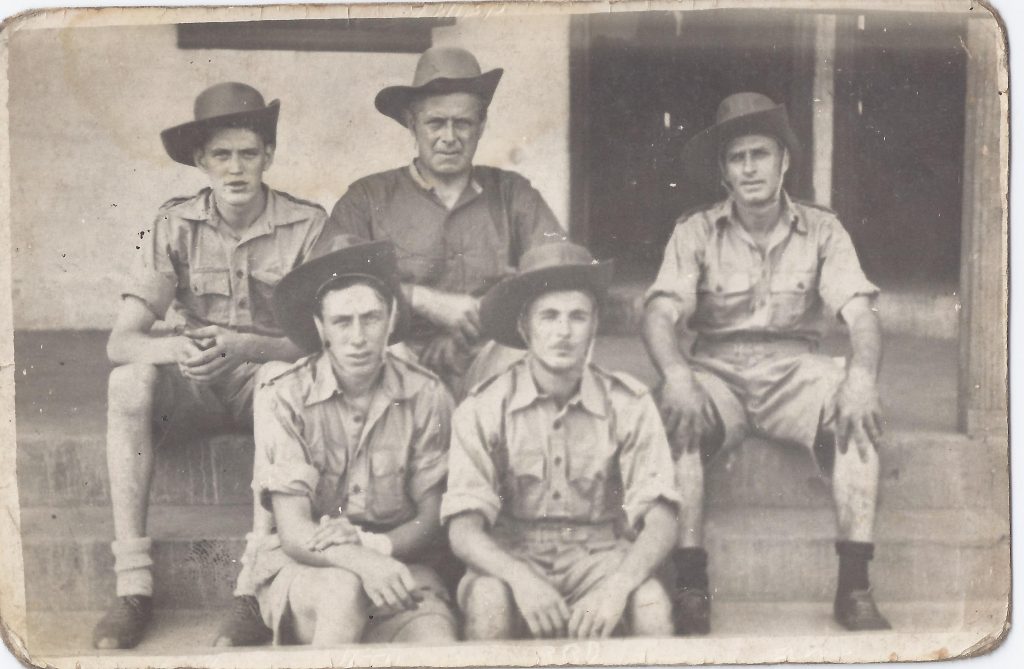
The following is an extract from a story submitted to the BBC WW2 ‘People’s War’ Web Site by Betty & Don TEMPEST of Lancshomeguard on behalf of Bob LANG and has been added to the Web Site with his permission. It tells the story of the sinking of SS Kingswood and the colorful adventure that followed.
“Discharged at Sea”
In 1943, I joined the SS Kingswood at Liverpool. We set sail and landed in Lagos, West Africa. After loading up with cargo we left on the 17th. December 1943 and set sail for the U.K. By then, because of training, I was a Quartermaster, in charge of steering the ship. We were sailing through the Gulf of Guinea, off the Ivory Coast and I was steering. The time reached Eight Bells (8pm), I was relieved, and I went for my ‘Black Pan’ evening meal. (Called that because it was the best meal of the day) I went down into the Mess Room where a lot of off duty lads were. I was just about to start eating when suddenly the ship rose up, dropped down and listed over onto the Starboard side, which is the right going forward. The ship was still travelling about 14knots. Immediately the Captain ordered ‘Abandon Ship’ over the warning system and all lights went out. Suddenly there was another explosion as a second torpedo hit the ship. I was thrown into the sea and went straight down under the water. My whole life passed before my eyes and I honestly thought I was dying.
We lay in the water for some time and then heard shouting, ‘Any Survivors?’ It was our lifeboat packed with survivors. It was only supposed to hold 14, but 59 were on board. They grabbed us and managed to pull us into the boat, but we had to be very careful. No moving about, it was very low in the water and could easily tip over. It was very dark and then we heard an engine, then a searchlight. It was the ‘U-Boat that had sunk us. We waited with our heads bowed, thinking we would be shot, but the ‘U-Boat left us and sailed away.
We drifted about 2 days. On the 3rd morning we saw specks on the horizon. They got nearer and we saw African fishermen from Grand Popo in large 70 foot canoes. They were a bit wary until one of our Officers held up his wristlet watch, then they came, rescued us in their canoes, and took us ashore. When we reached the beach we crawled ashore. We’d been cooped up in a lifeboat for three days and were very stiff, cramped and exhausted. We’d had no food and very little water, and the sun had burnt us all. It was wonderful being rescued. And we were very grateful.
Our Captain decided we couldn’t stay there forever, so we began to walk up the beach. Each village we passed, children came down, dancing round us and nearly driving us into the sea. They thought it was fun, but we were a bit worried. After about 14miles, guessing of course, we decided to go inland but had no idea where we were. We met up with another Tribe and they looked after us for a while. One day they killed a wild boar, roasting it over a fire. When it was ready we ate it. It was lovely. We stayed for 2/3days, but had to keep moving, so continued into the jungle, and met a tribe of Pygmies. They were shy and reluctant at first, but the drums must have been beating because they started looking after us. After a couple of days with the Pygmies we set off again. Suddenly, just before sunset, our rescuers, the Royal West African Frontier Force, came out of the jungle and found us. They had got messages over the Drums and been looking for us for days. Next day we were taken to an abandoned Foreign Legion Post and slept on old folding bunk beds. We stayed in the Foreign Legion Post for 2 days and then set off, driving through the jungle on the three wagons. We reached a wide river and were taken across on a huge raft. One wagon at a time with men on it. Then back for the others. Eventually we made it across.
The jungle was too thick for big wagons so we transferred to ‘Mammy’ wagons. Small, like jeeps. It took all day and we were exhausted. Eventually we reached Accra on the Gold Coast. I went to 37 General Hospital and spent some time there having my injuries attended. I was given an Army Uniform and went to Takordi Army base to join the rest of my shipmates. The sad thing was that, because we had been sunk at sea, we had officially been “Discharged at Sea”. This, in those days, was the way the Merchant Navy operated. If any seaman was sunk at sea they were automatically discharged from the Merchant Navy.
We spent our time at Takordi with the Forces, training to invade Burma. We also went to the docks, hoping to find seamen we knew and longing for a ship home. Not long after there was a ship to take us home, SS Orduna. She took us to England, calling at Gibraltar where HMS Warspit joined us, coming home with us for ‘D’Day. We landed at Liverpool, went through Intelligence, got our trains and went home. That was five months after the sinking and being ‘Discharged at Sea’.
